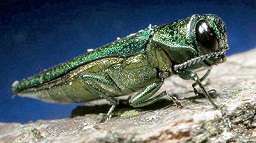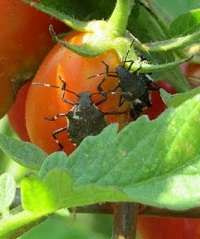Emerald Ash Borer
Two invasive insects from Asia are poised to cause millions of dollars in destruction in Maryland and throughout the United States. Although no definitive methods exist to stop them just yet, University of Maryland researchers are studying the threat and trying to develop safe and effective solutions.
The emerald ash borer and the brown marmorated stinkbug have already caused tremendous damage throughout the country. Their impact is huge: the ash borer targets and kills every species of ash tree it encounters; the stinkbug eats crops, invades homes, and smells awful when crushed.
The emerald ash borer has destroyed millions of ash trees in fourteen states. The first Maryland appearance was in Prince George's County in 2003. Since then it has slowly become a huge threat for the state's lumber business. Lumber is the second-largest industry in Maryland.
So far Maryland officials say the borer is in five counties and spreading quickly. It currently threatens tens of thousands of trees as it moves about a mile per year.
At this rate the pests could reach Baltimore in just five years, where ash is the most common tree (at about 10.4% of total tree population). Experts say this would signal a statewide invasion and a major concern for the state budget. The US Department of Agriculture estimates the borer will cost the Baltimore area alone over $200 million.
Costs would include removal of dead trees that pose risk of falling, and incinerating the wood to prevent the bug's spread. If the borers are left alone, the estimated national cost will be from $20 to $60 billion. And alongside is major - perhaps irreparable - ecological and aesthetic damage.
The brown marmorated stinkbug has been spotted in Maryland and 32 other states across the country. In 2010 the state's Catoctin Mountain Orchard lost 20% of its produce. University of Maryland researcher Paula Shrewsbury says some orchards lost up to 80%. But the stinkbug does more than attack produce: in the winter they travel into homes to hibernate. Stinkbugs breed very quickly and can completely overrun a house.
Brown Marmorated Stink Bug
Maryland is just beginning its battle against the invaders. Professor Mike Raupp is an entomologist at the University of Maryland and is exploring ways to monitor, control, and destroy the insects. He says part of the problem is that they have no natural predators, so it's hard to stop their growth. Also, there is an ongoing search for the most effective and safe pesticide. Researchers at Maryland and elsewhere are working on a wide range of solutions to deal with the stinkbug including predator wasps from Asia to genetically altered fungi.
Researchers are still looking for creative ways to solve the state's insect problems. Farmers have tried covering their crops with light permeable nets, alternative pesticides are being tested, and some people are using pheromones to design stinkbug traps. Continued testing might slow the spread enough for a solution to be found that saves millions more trees and crops from destruction.
Provided by University of Maryland






















